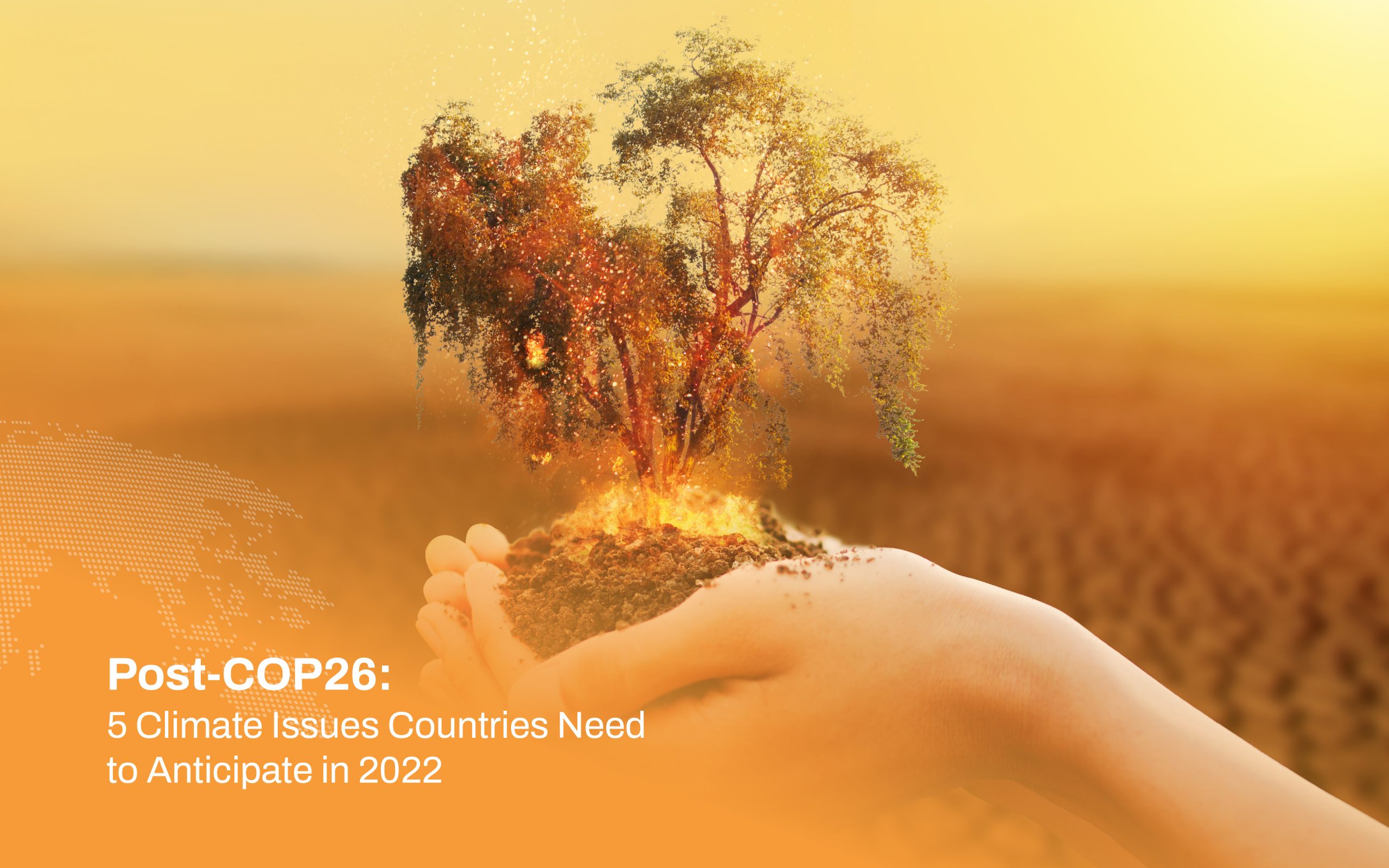The 2021 United Nations Climate Change Conference (COP26) held in Glasgow was a crucial moment in our battle against one of the most significant issues in human history; climate change. Negotiations lasted for two weeks, with the Glasgow Climate Pact as the final outcome of the summit.
At least 137 countries have reached an agreement for new net-zero pledges to strengthen their strategy and support the agenda of limiting global warming below 2℃, preferably 1.5℃, as stated in the Paris Agreement 6 years ago. In addition, over 40 countries agreed to phase-out coal power, ending all investment in new coal and power generation. The coalition also decided to channel the funds to “rapidly scale up” deployments in clean power generation.
As the core of climate actions, cities and local governments showcased their progress in COP26 to achieve net-zero by 2030. Cities and local governments have an essential role in responding to various shocks such as biodiversity loss, climate emergency, pandemic, and pollution. In addition, they also act as a catalyst in promoting transformative policies, in this case, to fight climate change, pushing the national governments to take more ambitious climate action.
However, our journey in fighting the climate crisis does not just stop with the end of COP26. In 2022, experts predict that several climate issues will become a top priority, such as phasing out fossil fuel funding and paying for climate loss and damage.
Then, what are the climate issues that need to be anticipated in 2022? Below is a brief review.
5 climate issues to anticipate in 2022
2022 is predicted to be a momentous year in enhancing our ambitions for better climate action. Climate policy analysts have warned that the Paris Agreement main target, while convincing, will be challenging to achieve over time, given the current state of our planet.
COP26 has issued a ‘compromise’ deal on climate, but it is barely enough. “We did not achieve these goals at this conference. But we have some building blocks for progress,” according to António Guterres, the United Nations (UN) Secretary-General. Therefore, we all must immediately move into ‘emergency mode’ by translating every commitment that has been made in COP26 into accurate and rapid climate action.
With that said, the following are the climate trends that everyone needs to anticipate in 2022:
1. Faster and bigger emissions cuts
Attempts to cut carbon emissionspollution really need to be improved to achieve the target of limiting global warming below 2℃, preferably 1.5℃. The contributions for faster and more significant emissions cuts from the largest contributor of greenhouse gases such as the United States, China, India, Russia, Japan, and the members of the European Union are absolutely necessary for this matter.
Moreover, the fact that the COP26 pact and Nationally Determined Contributions (NDCs) previously approved by the Parties will not be effective enough to prevent a climate crisis. But the good news is, by the end of this year, Parties agreed to revise and enhance their targets under NDCs to meet the 1.5℃ goal, which was usually done every five years.
Therefore, 2022 is an important year for every country to dramatically strengthen its commitment and pledge to minimise the adverse effects of climate change on the general public and our planet as a whole.
2. Phasing out the funding for fossil fuels
Countries this year are expected to immediately cut their support and subsidies for fossil fuels as one of the results of the agreement under COP26, including coal, oil and gas. The decision was based on the reason that funding, subsidies, and technical assistance for fossil fuels hindered the transition to renewable energy sources for a better future.
The transition from fossil-fueled economic growth to renewable energy sources became one of the important topics discussed in COP26, as countries were encouraged to reduce the fixation upon the use of unsustainable resources to fuel their respective economic activities, particularly coal.. As the dirtiest fossil fuel, coal was a significant concern during the negotiation. The climate summit reached an agreement to phase out unabated coal power generation by 2030 for the developed nations and 2040 globally. It was noted that 40 countries agreed to the deal, including the world’s top power-generating countries such as Indonesia, Poland, South Korea, Ukraine, and Vietnam.
3. Clean power transition
The transition from fossil fuels to renewable energy sources will certainly not just happen instantly. Countries need to face many challenges, especially concerns about the impact of the transformation on workers who are now in the biggest carbon emitter industries.
This year, the governments are expected to immediately prepare everything related to the transition. One of them is by promoting green jobs and creating new funding to replace the industries in the fossil fuels sector, as well as intensifying nature-based solutions which will indirectly insinuate to the public that they are serious about switching to a green economy.
At COP26, donor governments have agreed on a decision to fund cooperation programs for developing countries that still have a high dependence on coal to immediately switch to renewable energy. Therefore, in 2022, it is predicted that there will be more actions to achieve the clean power transition.
4. Adapting to climate change impacts
In 2021 and the years before, we have seen how climate change significantly affects our planet’s life. Species extinction, more widespread disease, unliveable heat, ecosystem collapse, cities menaced by rising seas, and various climate-related disasters have threatened our existence, especially those from vulnerable communities.
A report, which is currently still in the drafting process and will be published in February 2022 from the Intergovernmental Panel on Climate Change (IPCC), suggests that the worst is yet to come. We should not only focus on climate adaptation for the current circumstances but also on planning for the future.
Thus, this year, adapting to climate change impacts remains a trend that needs to be addressed and even strengthened by all parties in order to achieve the Paris Agreement targets.
5. Paying for climate loss and damage
According to the report from the World Meteorological Organization (WMO), between 1970-2019, there have been at least 11,000 climate-related disasters worldwide, with 2 million deaths and losses of around US$ 3.64 trillion. The frequency of these disasters is expected to increase if our fight against climate change continues to stagnate. As the most carbon emitters, wealthy nations are considered to have a big responsibility in this phenomenon. They will be expected to help finance vulnerable nations adapt to climate change impacts.
Hence, at COP26, paying for climate loss and damage became one of the critical issues that received attention from many Parties. For the poor and vulnerable nations with minimal contribution to the climate crisis, the terrible impacts of climate disasters are a matter of life and death for them. For example, women and girls must walk further to collect water and fuel, and are often the last to eat. With climate change in mind, vulnerable groups can face double the burden. Furthermore, populations living in coastal areas tend to be faced with flooding and erosion that threatens basic services such as water, houses, and even internet access – thus threatening their ways to make a living. In fact, the subject of “climate justice” were quite actively echoed through the conference. Acknowledging that climate change can lead to inequality, “climate justice” believes that those who are disproportionately impacted by climate change tend not to be those most responsible for causing it. These countries believe they have a moral right to compensation from wealthy nations for the damage done to lives, environments, and infrastructures due to climate change.
However, negotiations on the issue of loss and damage at the conference were tough and did not deliver any meaningful results.
Therefore, in 2022, paying for climate loss and damage is predicted to be a top priority in the discussion of climate change. COP27, which will be held in Egypt, is expected to be able to find a way out of the failure of wealthy nations to deliver US$ 100 billion a year from 2020 to vulnerable countries to adapt to climate change impacts and accelerate the transition to green energy.
Southeast Asia: Dilemma on climate pledge and economic growth
As discussed in the previous section, the transition from fossil-fueled economic growth to renewable energy sources is one of the crucial issues that got special attention in COP26. The commitment to phase out unabated coal power generation by 2030 for the developed nations and 2040 globally was endorsed by at least 40 countries, including several Southeast Asia nations, such as Brunei Darussalam, Indonesia, the Philippines, Singapore, and Vietnam.
However, overall, the Southeast Asia region is experiencing a dilemma on the climate pledge and economic growth. As the home to coal-dependent countries, the coal industries in Southeast Asia have at least undergone a drastic increase between 2005 and 2018. Several efforts have been made in the region to reduce excessive coal use, such as issuing the ASEAN Plan of Action for Energy Cooperation (APAEC). But unfortunately, until now, there has been no significant progress in achieving the targets set.
The end of COP26 and the signing of the Global Coal to Clean Power Transition Statement showed great enthusiasm, hope, and intention from the Parties to immediately end the use of fossil fuels and move to clean power. These changes must also be implemented as soon as possible in the Southeast Asia region.
Some substantial progress by Southeast Asian countries has been demonstrated in the post-COP26. Brunei Darussalam some time ago announced its climate ambition of moving towards net-zero by 2050. Although the country only contributes 0.025% of total global greenhouse emissions, Brunei believes that the commitments it holds in the future will significantly impact the whole world. Apart from Brunei, Singapore also continues to promote the transition to renewable sources to the public through the Long-Term Low-Emissions Development Strategy.
Countries in Southeast Asia face several obstacles to the transition to green energy, such as Vietnam, Indonesia, and the Philippines. In the case of Vietnam, although the country is currently leading in the progress of developing renewable energy with an eight-fold increase in rooftop solar, which contributed at least 9.3 gigawatts (GW) to its national grid at the end of 2020, due to fluctuating supply-demand on the solar grid, Vietnam is at risk of having to return to the use of fossil fuels. Moreover, Indonesia and the Philippines did not fully adopt the Global Coal to Clean Power Transition Statement at COP26, under the rationale of minimising the issues that emerged due to potential breaches of contract and the fact that the country is not a significant emitter of greenhouse gases, respectively.
If the Southeast Asia region cannot cut its dependence on fossil fuels, it is feared that there will be a scarcity of energy in the future. The region is predicted to become an importer of natural gas and coal in the future, and domestic energy needs may not be fulfilled if Southeast Asia does not immediately seek renewable energy sources as an alternative.
Therefore, acceleration on a transition away from unabated coal power generation and other fossil fuels is needed to achieve the targets in the Paris Agreement. The Southeast Asia region must immediately scale up the deployment of clean and renewable energy sources in an accessible and affordable way.











